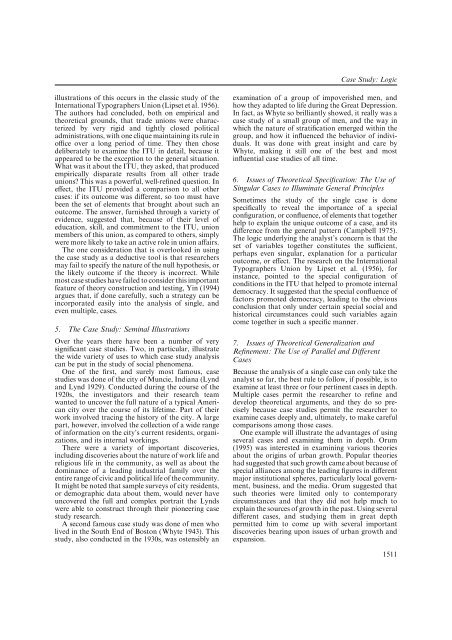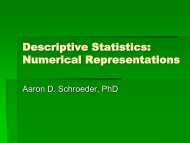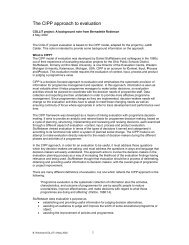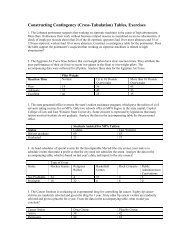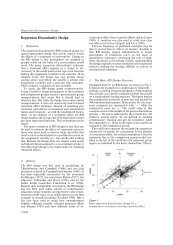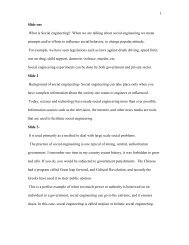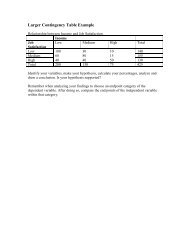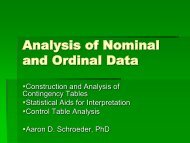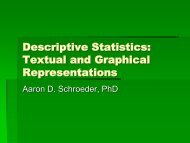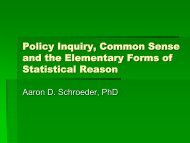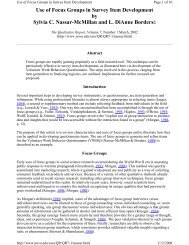Case Study: Logic
Case Study: Logic
Case Study: Logic
You also want an ePaper? Increase the reach of your titles
YUMPU automatically turns print PDFs into web optimized ePapers that Google loves.
<strong>Case</strong> <strong>Study</strong>: <strong>Logic</strong><br />
illustrations of this occurs in the classic study of the<br />
InternationalTypographers Union(Lipset etal. 1956).<br />
The authors had concluded, both on empirical and<br />
theoretical grounds, that trade unions were characterized<br />
by very rigid and tightly closed political<br />
administrations, with one clique maintaining its rule in<br />
office over a long period of time. They then chose<br />
deliberately to examine the ITU in detail, because it<br />
appeared to be the exception to the general situation.<br />
What was it about the ITU, they asked, that produced<br />
empirically disparate results from all other trade<br />
unions? This was a powerful, well-refined question. In<br />
effect, the ITU provided a comparison to all other<br />
cases: if its outcome was different, so too must have<br />
been the set of elements that brought about such an<br />
outcome. The answer, furnished through a variety of<br />
evidence, suggested that, because of their level of<br />
education, skill, and commitment to the ITU, union<br />
members of this union, as compared to others, simply<br />
were more likely to take an active role in union affairs.<br />
The one consideration that is overlooked in using<br />
the case study as a deductive tool is that researchers<br />
may fail to specify the nature of the null hypothesis, or<br />
the likely outcome if the theory is incorrect. While<br />
mostcasestudieshavefailedtoconsiderthis important<br />
feature of theory construction and testing, Yin (1994)<br />
argues that, if done carefully, such a strategy can be<br />
incorporated easily into the analysis of single, and<br />
even multiple, cases.<br />
5. The <strong>Case</strong> <strong>Study</strong>: Seminal Illustrations<br />
Over the years there have been a number of very<br />
significant case studies. Two, in particular, illustrate<br />
the wide variety of uses to which case study analysis<br />
can be put in the study of social phenomena.<br />
One of the first, and surely most famous, case<br />
studies was done of the city of Muncie, Indiana (Lynd<br />
and Lynd 1929). Conducted during the course of the<br />
1920s, the investigators and their research team<br />
wanted to uncover the full nature of a typical American<br />
city over the course of its lifetime. Part of their<br />
work involved tracing the history of the city. A large<br />
part, however, involved the collection of a wide range<br />
of information on the city’s current residents, organizations,<br />
and its internal workings.<br />
There were a variety of important discoveries,<br />
including discoveries about the nature of work life and<br />
religious life in the community, as well as about the<br />
dominance of a leading industrial family over the<br />
entirerangeofcivicandpoliticallifeofthecommunity.<br />
It might be noted that sample surveys of city residents,<br />
or demographic data about them, would never have<br />
uncovered the full and complex portrait the Lynds<br />
were able to construct through their pioneering case<br />
study research.<br />
A second famous case study was done of men who<br />
lived in the South End of Boston (Whyte 1943). This<br />
study, also conducted in the 1930s, was ostensibly an<br />
examination of a group of impoverished men, and<br />
how they adapted to life during the Great Depression.<br />
In fact, as Whyte so brilliantly showed, it really was a<br />
case study of a small group of men, and the way in<br />
which the nature of stratification emerged within the<br />
group, and how it influenced the behavior of individuals.<br />
It was done with great insight and care by<br />
Whyte, making it still one of the best and most<br />
influential case studies of all time.<br />
6. Issues of Theoretical Specification: The Use of<br />
Singular <strong>Case</strong>s to Illuminate General Principles<br />
Sometimes the study of the single case is done<br />
specifically to reveal the importance of a special<br />
configuration, or confluence, of elements that together<br />
help to explain the unique outcome of a case, and its<br />
difference from the general pattern (Campbell 1975).<br />
The logic underlying the analyst’s concern is that the<br />
set of variables together constitutes the sufficient,<br />
perhaps even singular, explanation for a particular<br />
outcome, or effect. The research on the International<br />
Typographers Union by Lipset et al. (1956), for<br />
instance, pointed to the special configuration of<br />
conditions in the ITU that helped to promote internal<br />
democracy. It suggested that the special confluence of<br />
factors promoted democracy, leading to the obvious<br />
conclusion that only under certain special social and<br />
historical circumstances could such variables again<br />
come together in such a specific manner.<br />
7. Issues of Theoretical Generalization and<br />
Refinement: The Use of Parallel and Different<br />
<strong>Case</strong>s<br />
Because the analysis of a single case can only take the<br />
analyst so far, the best rule to follow, if possible, is to<br />
examine at least three or four pertinent cases in depth.<br />
Multiple cases permit the researcher to refine and<br />
develop theoretical arguments, and they do so precisely<br />
because case studies permit the researcher to<br />
examine cases deeply and, ultimately, to make careful<br />
comparisons among those cases.<br />
One example will illustrate the advantages of using<br />
several cases and examining them in depth. Orum<br />
(1995) was interested in examining various theories<br />
about the origins of urban growth. Popular theories<br />
had suggested that such growth came about because of<br />
special alliances among the leading figures in different<br />
major institutional spheres, particularly local government,<br />
business, and the media. Orum suggested that<br />
such theories were limited only to contemporary<br />
circumstances and that they did not help much to<br />
explain the sources of growth in the past. Using several<br />
different cases, and studying them in great depth<br />
permitted him to come up with several important<br />
discoveries bearing upon issues of urban growth and<br />
expansion.<br />
1511


